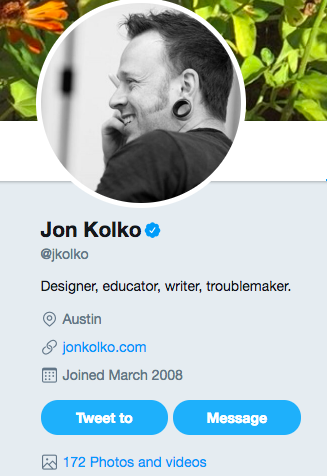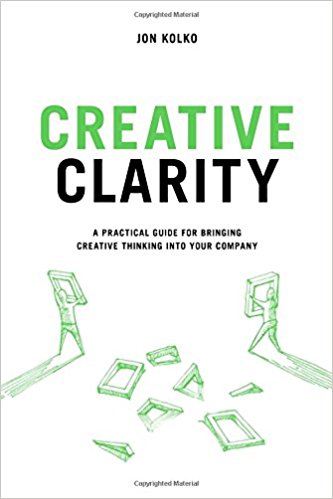We all know of the importance of innovation fuels our businesses. Especially those of us who run startups, it is a non-negotiable that we think creatively when solving problems, finding and managing resources. Having a creative approach to our product also helps create loyal customers and users.
Studies have shown that creative companies usually outperform their peers in several key performance indicators. Since it is clear that creative thinking is crucial for any business to grow, how do we bring that creativity to our businesses? We had a chance to interview an expert on the topic; founder, author, and professor, Jon Kolko.
Jon Kolko is the author of Creative Clarity, Partner at Modernist Studio, and the Founder of Austin Center for Design. Previously the Vice President of Design at Blackboard, he has worked extensively with both startups and Fortune 500 companies. He has been a Professor of Interaction and Industrial Design at the Savannah College of Art and Design, and has taught at the University of Texas at Austin, the Center for Design Studies of Monterrey, Mexico, and Malmö University, Sweden.
When you’re done reading the interview, don’t forget to follow Jon on Twitter.
Q. Welcome to StartUp Mindset, Jon. We’re excited to have you here. For the readers who are not familiar with you, could you tell us a little about yourself and your background?
I’ve been working in the field of design strategy for almost 20 years, and I’ve had the opportunity to work in a variety of context. I’ve worked at large companies, small ones, educational institutions, and startups. I was a creative director at frog design, a global innovation firm.
I was the VP of Design at MyEdu, a company that helped college students succeed in college and get jobs. That startup was acquired by Blackboard, the large educational software company. Eight years ago, I founded Austin Center for Design, a school in Austin that teaches students design and social entrepreneurship. And, in early 2017, my colleagues and I started Modernist Studio, an agency that helps companies bring creative problem solving into their organizations.
I’m passionate about the power of design: to support companies as they think about hard problems and market opportunities, and to help them identify what to build, and to help them build it.
Q. Most people think of creativity as something you have or are just born with. However, in your book, you explain how creativity is a process. Can you tell us more about that?
A lot of scientific research identifies that people are born with a predilection towards various abilities and ways of thinking, like creativity. But it’s not set in stone. Those of us who aren’t from a long family line of guitar players can still learn to play the guitar with the right training and perseverance. I teach a lot, working with both graduate students and executives and everything in between.
Many of them self-define as “not creative.” But we learn a process, one that adopts a way of thinking and then pairs that with developing craftsmanship. That process emphasizes problem framing, iteration, critique, and storytelling.
Problem framing is about structuring boundaries around a problem so that it can become less ill-defined. In many traditional business contexts, these boundaries are defined top-down: autocratically prescribed as a series of requirements. But in a creative context, boundaries emerge bottom-up, through exploration.
There’s a phenomenon of “talk back” – that as you make something, you observe and implicitly react to what you made, and identify ways to make it better. The “ways to make it better” point at a problem frame, or series of constraints that then inform the next iteration.
And this is our second part of the process – that creativity is not a one and done activity, but instead, it’s ongoing. That back and forth between the designer and the thing being made means that one thing leads to another and to another. Through this iteration, new ideas are sparked, and emerging ideas are refined. It sounds amorphous, but the problem starts to “form” just as the solution gains form.
That solution is influenced by criticism, which is the next part of the process. Most of us have self-criticism. We look at what we made, and since our taste is more refined than our skill, we aggressively (and negatively) think about how we didn’t do a good job, or we aren’t good enough. We transfer our feelings about the work artifact to ourselves, and that limits the breadth and continuity of subsequent iterations. And so I teach students how to hold a critique, which is a special form of meeting. In this meeting, artifacts are presented, but not defended or explained. As the creator sits quietly and takes notes, the other members of the critique identify areas where the design can be improved, firmly embedding criticism in the work product, not the person who made it.
The last part of the creative process that I teach emphasizes narrative and storytelling. In some creative contexts like artwork in a museum, work stands on its own. But in a business context, there’s a need to evangelize and persuade people that ideas that don’t yet exist are worth existing. Put another way, we need to become adept at convincing people that what we’ve created is the right thing to make. This isn’t about opinions, because that’s a losing battle. Instead, it’s about helping people see how the thing that’s been made will be great: it will solve the business problem, delight customers, generate revenue, or fulfill whatever goal it’s intended to fulfill. It’s about telling a persuasive story.
This is a messy process, and part of what creative people realize is that even when you learn a nice crisp way of doing things, that’s rarely how it plays out in real life. And so we also teach a way of coming to terms with the mess – of embracing the chaos.
Q. In May 2014, Adobe commissioned Forrester Consulting to investigate how creativity influences business outcomes. This study found that companies that embrace creativity outperform their peers on key business indicators such as profit, revenue growth, and talent acquisition. Why do you think creative companies outperform their peers?
I’ve read the study – The Creative Dividend. The study identifies some traits of creativity: setting specific criteria or goals meant to inspire new ideas, seeking out customers to collaborate with, having a methodology for rating and funding new ideas, funding creativity, adopting technology early, and create novel customer interactions. I agree with a few of these, like funding creativity, but I’m a little turned off by some of the others.
Setting goals, rating ideas – these seem like characteristic of a test and measure culture, which is often at odds with a creative culture. Obviously, measurement isn’t at odds with product and service management and actually shipping products. But I’ve seen designers and technologists reject this way of thinking in the context of dreaming, which is a big part of their job. There’s a tension between running a successful business and building a creative powerhouse.
We need to attract creative people, and they come with expectations around how their job should work. Asking a technologist “when will you be done?” is one of the best ways to rub them the wrong way; this type of question implies that the creativity they need to do their work should be known ahead of time, or limited, or operationalized. It drives them crazy, and they won’t last long in a culture like that.
Q. One concept in your book that I found fascinating was the concept of “simplicity on the other side of complexity” and how it relates to problem-solving. Could you tell us a little about this concept and how it can help entrepreneurs solve problems and spark innovation?
I learned the idea of “simplicity on the other side of complexity” from my friend Frank Lyman, the head of product at the startup MyEdu. He draws a simple bell curve. At the left of the curve is the beginning of a creative exploration, and the people involved are looking at a blank slate of exploration. This is true even in the context of an existing problem: their personal engagement hasn’t started yet, and so they are happily naïve in their newness. But as they dive in, they start to be overwhelmed by the system. During a creative exploration, the problem becomes harder before it becomes easier. Exploration and iteration take us in all sorts of strange directions, and frequently, we end up adding complexity to the problem. That’s our trip up the complexity bell curve.
And at some point, we hit the top. We’ve completely screwed up the creative canvas. In old-school non-digital industrial design shops, this is evidenced by hundreds of drawings on the floor and on the wall: witness a designer, completely overwhelmed by what they’ve made.
Unfortunately, this may be when they’ve run out of time, and they’re left to present their complexity to other people. If you’ve ever been in a meeting where an analyst spews out pages and pages of numbers and graphs in small type on a powerpoint slide, you are getting a glimpse of them at the peak of the complexity curve.
But as the creative process continues, we start to find our way to simplicity. We remove potential ideas from the solution space. We combine and merge ideas and thoughts, and refine through critique. And at the far edge of the bell curve is simplicity on the other side of complexity. This is the stuff of awards and accolades and unboxing and pats on the back. This is where creativity really sings.
The model is useful because it reinforces two things. First, for someone entrenched in a creative mess at the top of the curve, it’s encouraging because it says – “keep going”. You’ll find your way out through iteration and exploration. And, it says – “give us more time”. In contexts like startups and other small companies, time seems to be the rarest resource. For leadership to understand and embrace a model like simplicity on the other side of complexity reminds us that no matter how fast we’re running, some creative activities Just Take Time.
Q. In your book, you outline a few ways leaders can build a creative culture. What is one thing that leaders could do right away that would help foster a culture of creativity within their startups?
Instill a model of creative critique, by leading by example. As a leader, you make things. They probably aren’t sketches or code (although they may be) – often, they are business plans, or board of director presentations, or strategy artifacts. If you want to get your team to embrace collaborative critique, show them what you mean. Print your presentation to the board, put it on the wall, gather the team, and discuss the rules. You aren’t going to talk, except to answer questions. You aren’t going to explain the work, which should stand on its own. You aren’t going to defend it or rationalize it. You are just going to sit there and take notes. And you want the team to identify things that don’t make sense, or could be improved – and to offer ways to improve them.
Presenting yourself and your work as critiquable says: “work is malleable, and it isn’t precious. I’m open to hearing ways to improve this because I know you aren’t critiquing me. You are critiquing what I made. And I expect you to critique each other’s work, too.”
It’s worth noting (and saying outright in the meeting) that, after a critique, there’s no expectation that you will go do everything that was mentioned. These are inputs into the next iterations. Some will be integrated, and some rejected. It’s all part of the process.
Q. What advice would you give to someone who struggles to add creative thinking to their business?
A culture is shaped by the people in it. If you want to “be more creative”, hire people who act the way you aspire to act and work the way you aspire to work. But most importantly – if you bring them in, give them the runway to work their process. If you bring someone in to break glass, expect there to be a lot of it scattered on the ground.
Photo Credit: Edit Valle and Cedim News












